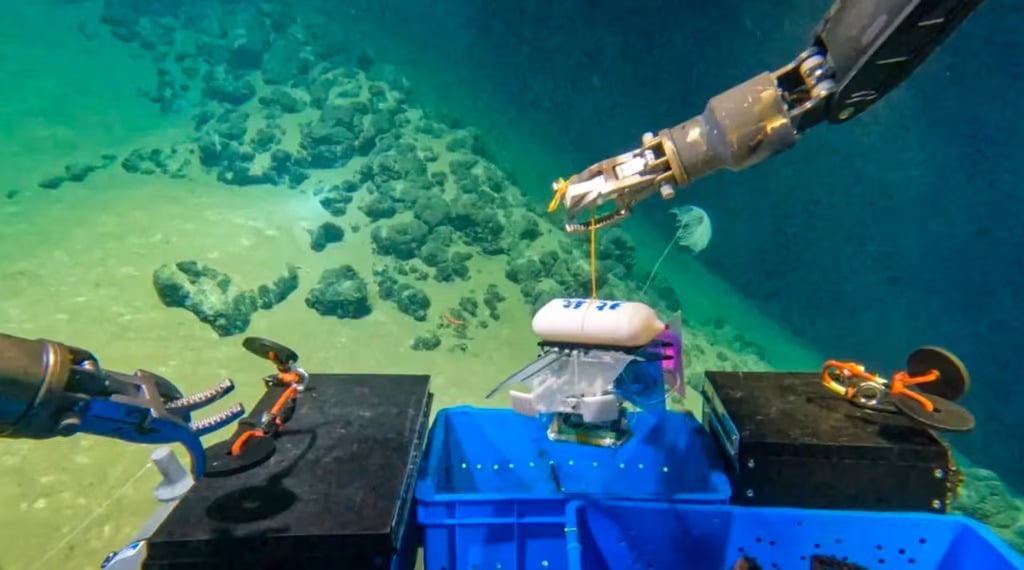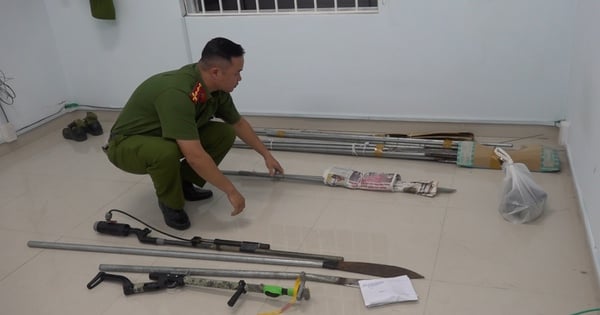(CLO) China has just announced a mini deep-sea robot that can operate in the Mariana Trench - the deepest ocean trench on Earth, marking a breakthrough in the ocean technology race.
In the western Pacific, at the strategic gateway to the second island chain, lies the deepest point on Earth—the Mariana Trench. In this dark world, China has just announced a technological breakthrough: a tiny drone no bigger than a briefcase that can operate at depths that even the US Navy’s equipment cannot reach.

A deep-sea drone is deployed to swim into the Mariana Trench. Photo: Beihang University
Developed by scientists at Beihang University in Beijing, the robot uses a smart metal actuator that converts extreme water pressure into thrust, allowing it to swim, glide and crawl through the Mariana Trench’s 10.7km-deep abyss – where the pressure is equivalent to carrying a giant iceberg on its back.
The landmark study, published in Science Robotics last week, shows the growing gap between China and the US in deep-sea technology. In 2024 alone, China made 246 deep-sea dives—more than all other countries combined—while the US still relies on its 61-year-old Alvin submarine, which can only dive to 6,500 metres.
Professor Wen Li's team's robot uses shape-memory alloys to help its actuators operate more efficiently under extreme pressure. When tested in the Mariana Trench, it was able to swim for 12 seconds, travel 0.4 meters, and crawl 32 mm in 6 seconds. After completing the mission, the robot was recovered intact.
The team also developed a soft gripper using the same SMA material that can collect marine life such as starfish, sea urchins and sea cucumbers from the ocean floor. They hope this research will pave the way for the next generation of miniature robots that can help explore the deep sea and interact with ocean ecosystems.

Diagram showing how the drone moves. Photo: Beihang University
China's Mariana Trench Environmental and Ecological Research (MEER) program is also making great strides. From 2020 to 2024, the Shenhai Yongshi (Deep Sea Warrior) and Fendouzhe (Striver) submarines completed 1,116 dives, taking 1,200 scientists to unprecedented depths. In 2024 alone, Fendouzhe made 31 dives over 37 days, including 7 trips to depths of more than 9,000 meters.
Meanwhile, the US still relies heavily on Alvin, a manned submarine famous for its 5,200 dives in history, which has explored hydrothermal vents, searched for missing hydrogen bombs, and surveyed the wreck of the Titanic. However, after being shut down for repairs and upgrades several times, Alvin has gradually shown its limitations compared to China's advanced unmanned underwater vehicles.
At the current pace of development, China's deep-sea technology could change the landscape of ocean research, while posing a major challenge to the United States in the undersea technology race.
Ngoc Anh (according to SCMP, Science Robotics)
Source: https://www.congluan.vn/trung-quoc-phat-trien-robot-lan-dau-cham-den-diem-sau-nhat-trai-dat-post340151.html


![[Photo] Dong Ho Paintings - Old Styles Tell Modern Stories](https://vstatic.vietnam.vn/vietnam/resource/IMAGE/2025/3/29/317613ad8519462488572377727dda93)


![[Photo] Prime Minister Pham Minh Chinh chairs meeting to urge highway projects](https://vstatic.vietnam.vn/vietnam/resource/IMAGE/2025/3/29/6a3e175f69ea45f8bfc3c272cde3e27a)
























![[Photo] Prime Minister Pham Minh Chinh and Brazilian President Luiz Inácio Lula da Silva attend the Vietnam-Brazil Economic Forum](https://vstatic.vietnam.vn/vietnam/resource/IMAGE/2025/3/29/f3fd11b0421949878011a8f5da318635)
























































![[REVIEW OCOP] An Lanh Huong Vet Yen Cat](https://vstatic.vietnam.vn/vietnam/resource/IMAGE/2025/3/27/c25032328e9a47be9991d5be7c0cad8c)







Comment (0)